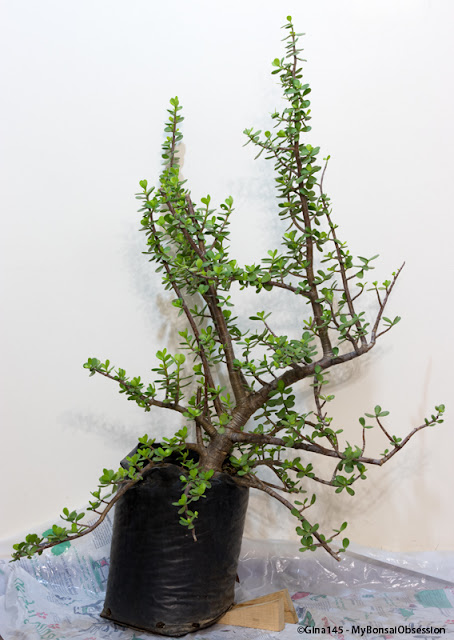I never meant to buy anything.
When I stopped at the nursery about 10 days ago, I was just trying to burn a little time before meeting a friend at a nearby restaurant. I'm supposed to be cutting down on the number of trees in my collection, not adding more.
Everything started off well. The trident maples had decent bases, but they were about 10 feet tall with no low branches, so they were easy to ignore. And the small Portulacarias weren't the least bit tempting. I've already got a few and I tend to neglect them. So much so that
I nearly lost one to root rot last year. I've reached the stage where I try not to buy anything unless it's a little bit special, like the
variegated Portulacaria I bought in July.
But when I passed the big Portulacarias in another section of the nursery, everything changed. I'm not aware of ever seeing them that size before - well not unless they were growing in the ground anyway. Even so I nearly passed them by because the bags of soil they were planted in were so big that I felt sure I wouldn't be able to lift them. But I tried lifting one and was surprised to find that it was a lot lighter than it looked.
I couldn't buy it though. Not that day. I couldn't leave it standing in the car, visible for all the world to see, while I was at the restaurant.
It was three days before I was able to return. Luckily my chosen plant was still there because the others had much thinner trunks. Well all except one, and it turned out that I couldn't lift that one.
And so I came home with this huge plant which, in its bag, reached to just below my chin.
 |
| October 2018 - as purchased |
I couldn't even contemplate putting it into a training pot until I'd removed all the excess growth.
 |
| October 2018 - after first rough pruning |
At this stage all the branches on the left were in a straight line and I knew most of them would have to go, but I decided to leave my final selection until the tree was in a pot, planted at the correct height. A wise decision because, by the time the highest roots were exposed, the tree appeared a couple of inches taller.
 |
| October 2018 - still waiting for its final cut |
I didn't discover that until a few days later though. Given its size I decided to get some help with the root work at my club's meeting.
In addition to adding height to the tree, removing the top layer of soil also exposed a couple of branches with their own roots, giving me two extra (much smaller) plants for my money.
 |
| October 2018 - two branches with their own roots |
Once the tree was safely potted, it was time for the final branch selection. I was happy to find that several club members agreed with my decision to reduce the height a little further. Once I'd cut back to my chosen leader, the right branch was perfectly positioned on the bend. After removing the handlebars and the low branch coming straight to the front, I was left with just two branches. For now.
 |
| October 2018 - after final pruning |
Who knows what options may present themselves when new growth appears?
It's unfortunate that the higher branch is the thicker of the two, but hopefully if I let the thinner one grow and keep the thicker one short, it won't take too long to correct that fault.
One last photo, just to show the size of the tree:
 |
| October 2018 - soda can for size |
In addition to the two branches with roots, I've kept a lot of cuttings. If they all root, I'll have a not-so-small forest of Portulacarias of various sizes growing in my bonsai area. Maybe in a year or so I'll be able to sell some of them and recover the cost of the parent tree.





















































